Robin Hardy’s The Wicker Man was released after years of behind-the-scenes drama and active efforts to impede its production. 30 years later, the Nicolas Cage version of The Wicker Man told the same basic story with a talented cast and strong technical credentials, only to be rapidly relegated to an internet punchline. The differences couldn’t be more stark, and much of it boils down to one simple change. The remake sees fit to create its own neo-pagan faith more or less out of scratch, while the original draws on ancient Celtic pagan traditions and practices.The Summerisle villagers in The Wicker Man practice an amalgamation of multiple traditional beliefs, which Hardy and The Wicker Man screenwriter Anthony Shaffer painstakingly researched as they were preparing the film. They filled the movie with copious examples, often as a part of the villagers’ day-to day-lives. The most prominent are discussed below, loosely in the order they appear in the film, along with the ancient pagan practices and beliefs that the filmmakers drew upon.May Day, or a variation, is a real-life European festival dating back to ancient times signaling the beginning of summer and the flowering of crops, and modern pagans still celebrate it. Maypoles are thought to have originated in Germany, representing everything from the axis of the world to a sacred tree. 2019’s folk horror film Midsommardraws on similar pagan festivities taking place later in the calendar year.
Robin Hardy’s The Wicker Man was released after years of behind-the-scenes drama and active efforts to impede its production. 30 years later, the Nicolas Cage version of The Wicker Man told the same basic story with a talented cast and strong technical credentials, only to be rapidly relegated to an internet punchline. The differences couldn’t be more stark, and much of it boils down to one simple change. The remake sees fit to create its own neo-pagan faith more or less out of scratch, while the original draws on ancient Celtic pagan traditions and practices.
The Summerisle villagers in The Wicker Man practice an amalgamation of multiple traditional beliefs, which Hardy and The Wicker Man screenwriter Anthony Shaffer painstakingly researched as they were preparing the film. They filled the movie with copious examples, often as a part of the villagers’ day-to day-lives. The most prominent are discussed below, loosely in the order they appear in the film, along with the ancient pagan practices and beliefs that the filmmakers drew upon.
May Day, or a variation, is a real-life European festival dating back to ancient times signaling the beginning of summer and the flowering of crops, and modern pagans still celebrate it. Maypoles are thought to have originated in Germany, representing everything from the axis of the world to a sacred tree. 2019’s folk horror film Midsommardraws on similar pagan festivities taking place later in the calendar year.
#Wicker #Man #Summerisle #Pagan #Traditions #Listed
Note:- (Not all news on the site expresses the point of view of the site, but we transmit this news automatically and translate it through programmatic technology on the site and not from a human editor. The content is auto-generated from a syndicated feed.))



